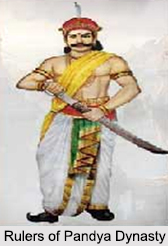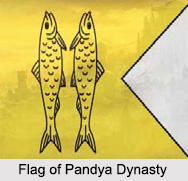 Pandya Kingdom was first mentioned by Megasthenese who said that their kingdom was famous for pearls. They occupied the region of the modern districts of Tirunelveli, Ramnad and Madurai in Tamil Nadu. Madurai was their capital, situated on the bank of River Vaigai.
Pandya Kingdom was first mentioned by Megasthenese who said that their kingdom was famous for pearls. They occupied the region of the modern districts of Tirunelveli, Ramnad and Madurai in Tamil Nadu. Madurai was their capital, situated on the bank of River Vaigai.
First Pandya Empire
Post Sangam period, the first Pandya empire was established by a King named Kadungon, who defeated Kalabras in 6th century AD. The successors of Kadungon indulged in fighting with the nearby Chera and Chola Kings. He is known for ending the Kalabhra rule, marking the beginning of a new era in the Tamil speaking region.
 Kochadaiyan Ranadhiran
Kochadaiyan Ranadhiran
Kochadaiyan Ranadhiran who ruled from 710-735 AD, asserted Pandya"s superiority over the Cheras and Cholas in the city of Mangalapuram, the modern day Mangaluru.
Maravarman Rajasimha II
Maravarman Rajasimha II ruled from 900-920 AD. He was the son and successor of Kochadaiyan Ranadhiran. Rajsimha II fled to Ceylon after this defeat and returned to Kerala, where he lived in low profile under a Chera King.
Srimara Vallabha
The last Pandya King of this first Pandyan Empire was Srimara Vallabha. He defeated the king of Ceylon. He had defeated a confederation of the Pallavas, Cholas, Gangas and other kings at a place called Kudamukku. The Pandyan king made several attempts from time to time to make themselves independent, but could not succeed.
Second Pandya Empire
Pandyas received the help of the king of Ceylon. Since this time the power of the Pandyas again increased and the power of the Cholas started declining. Jatavarman Kulashekhar ruled in 1190 A. D. Thus, for about a century Pandyas ruled over Dravida province.
Sundar Pandya
The power of the Cholas again increased during the reign of the successor of Jatavarman. But Sundar Pandya again defeated the Cholas and burnt the cities of Tanjore and Udaipur. Chola king Rajaraja III had to submit to the Pandyas and became a Samanta of the Pandyas.
Jatavarman Sundara Pandya
Jatavarman Sundara Pandya came to the throne of Pandya kingdom in 1251 A. D. He was a powerful king of his dynasty. After defeating the Cholas, he brought Kanchi under his control of his authority. He also helped Chera, Konga and Ceylon kingdoms to become independent. After conquering Hoyasala king Someshwara, he occupied fort of Koppama and drove away the Hoyasala king. He also defeated Kakatiya king Ganapati and Pallava king. He extended his empire up to Kadappa and Nellore.
Maravarman Kulasekhara
After the death of Jatavarman Sundar Pandya, Maravarman succeeded him as a king. He fought many wars and conquered Malaynadu i.e. Travancore, Simhala or Ceylon, etc. Maravarman Kulasekhara sent his minister Arya Chakravarti to attack Ceylon at the time when there was a famine in that island. Arya Chakarvarti conquered the fort of Subhagiri and plundered a lot of money for its ruler. For about 20 years, Ceylon remained under the control of the Pandya kings.
During the reign of Maravarman himself, there was a terrible war of succession in between his legitimate son Sundara and illegitimate son Vir Pandya. Maravarman was killed in this war of succession and Sundara approached Allauddin Khilji for his help. Seeing the revolt of the Pandyas, Allauddin`s general, Malik Kafur, took advantage of the situation by attacking Madurai. After some days, Allauddin again sent his general, Khusuru Khan who attacked Madurai and put an end to the rule of Pandya dynasty.



















